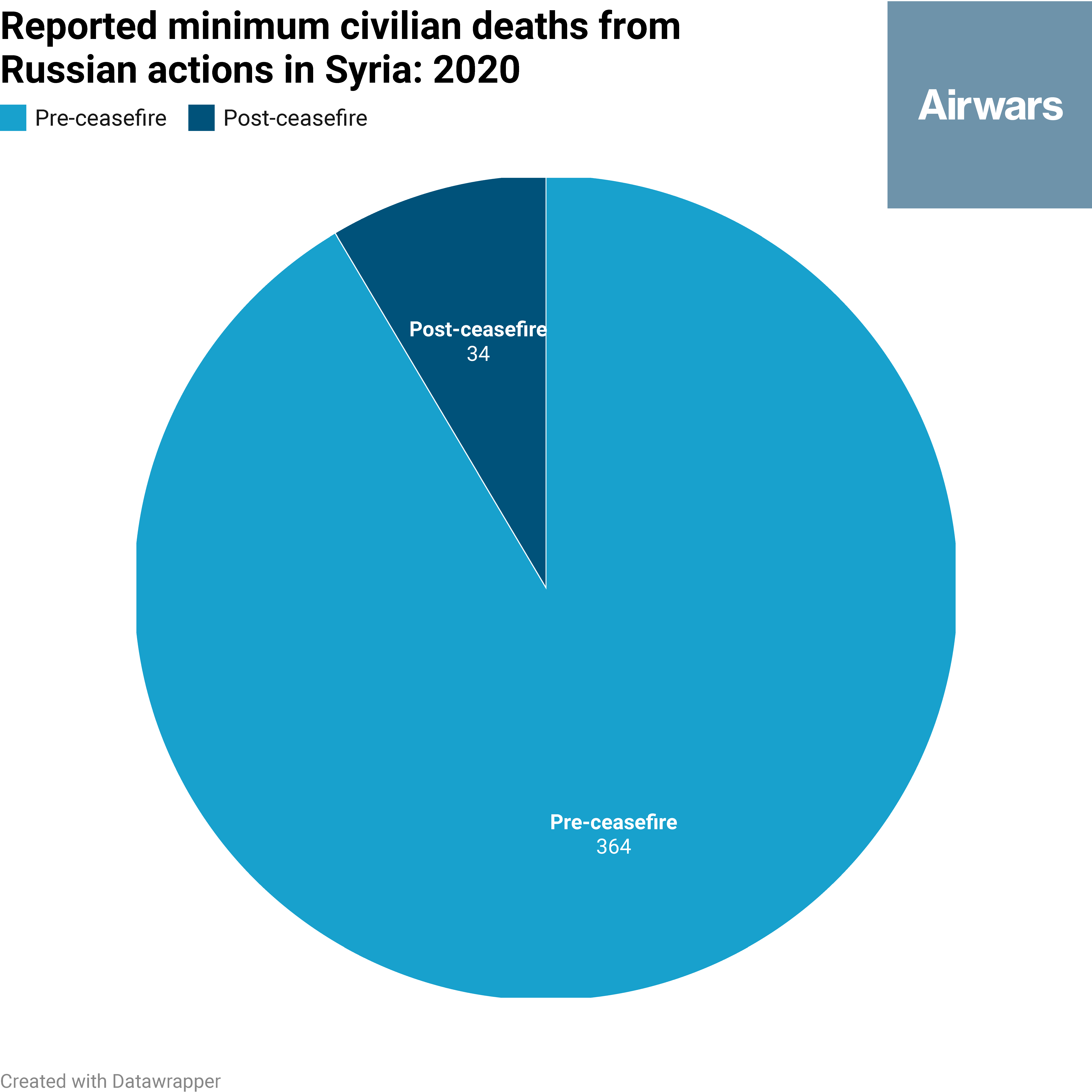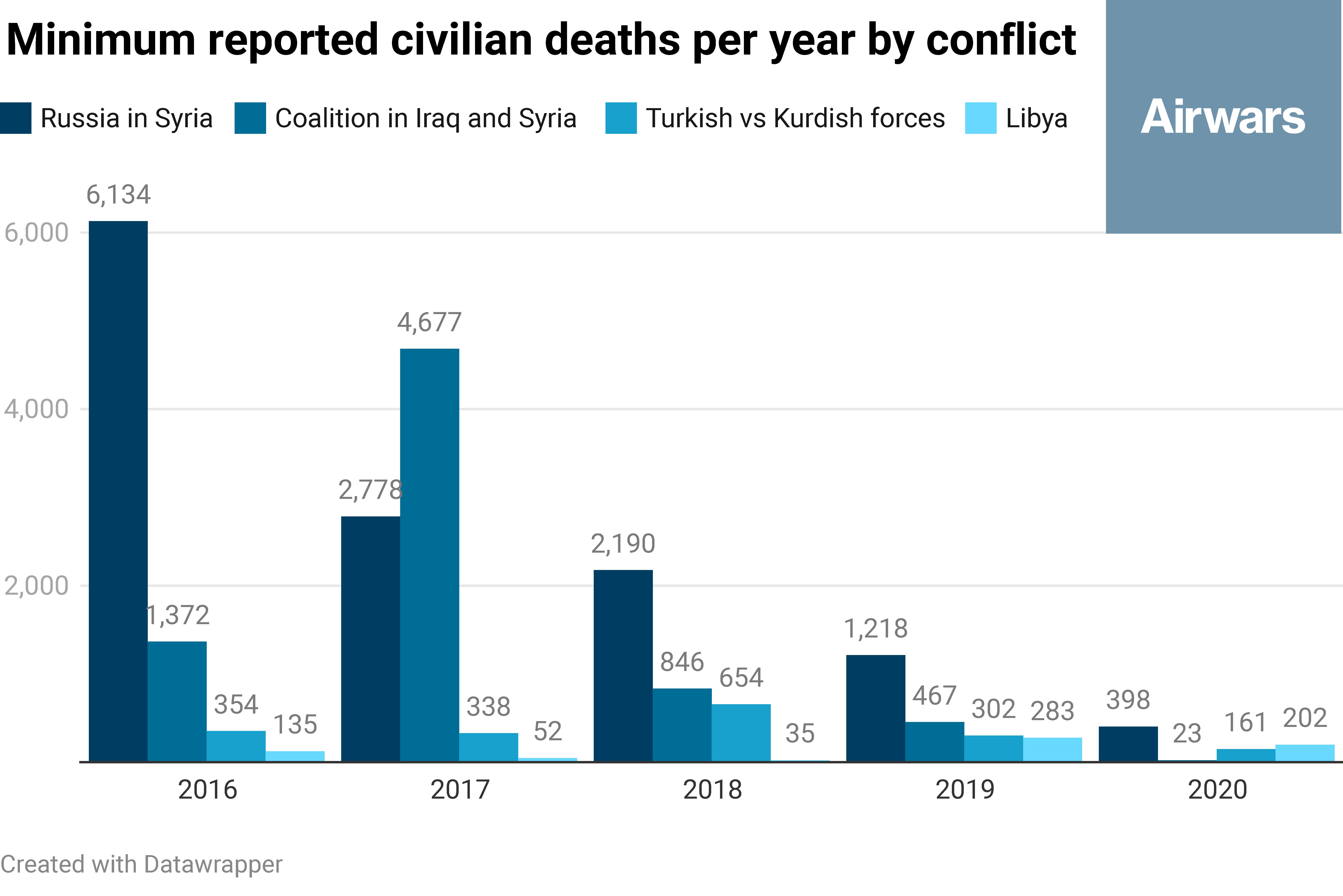US accountability for civilian casualties declines sharply during Trump's final year, as CENTCOM 'forgets' deaths of Yemen civilians.
Tracking by Airwars across multiple conflicts during 2020 shows that the number of locally reported civilian deaths from the use of explosive weapons was down by two thirds compared to the previous year. Of these fatalities, around half were in the first two months of 2020.
Comprehensive new data released by Airwars in its Annual Report 2020 suggests a possible ‘Covid effect’ – a significant reduction in conflict violence, as communities locked down during the global pandemic.
Other factors were at work too. Truce deals in Syria and Libya had a major impact in reducing civilian casualties. And the United States significantly scaled back its targeted strikes campaign in Yemen – though counterterrorism actions in Somalia continued at a high tempo. Meanwhile, limited Turkish military actions continued in both Iraq and Syria, sometimes with associated claims of civilian casualties.
“Any fall in reported civilian casualty numbers from their desperately high levels of recent years has to be welcomed,” says Airwars director Chris Woods. “Yet concerns remain that some of these wars will re-ignite as the impact of Covid recedes. Declines in US accountability for civilian deaths are also very worrying, and require urgent attention from the incoming Biden administration.”
US accountability challenges
Reported US actions declined steeply for the second year running – with no known US strikes in Pakistan or Libya, and significantly fewer in Yemen, Iraq and Syria. However US counterterrorism strikes remained at a high level in Somalia – with uncertainty about how many US actions in Afghanistan were conducted. In total, an estimated 1,000 US airstrikes took place during Donald Trump’s last full year as president – down from around 13,000 during Obama’s own final year in office.
Locally reported civilian harm was also sharply down. But as the Annual Report shows, so too was US public accountability. In Iraq and Syria, there was an unexplained 80 per cent fall in the number of events assessed as ‘Credible’ by the US-led Coalition. And in Yemen, US Central Command had to apologise after forgetting that its own forces had killed up to a dozen civilians in a 2017 raid – despite CENTCOM’s former commander having publicly confirmed those deaths to the US Senate.
Limited respite for Syria, Iraq
Russia and the Assad government began 2020 with a ferocious campaign targeting rebels in several governorates, including Idlib. However of at least 398 civilian deaths allegedly resulting from Russia’s actions in Syria last year, all but 34 occurred before a major ceasefire was enacted on March 5th. That pause in hostilities – which still mostly holds – was prompted both by Covid concerns, and as a result of military pressure by Turkey on Assad’s forces.
Turkey also continued its ongoing campaigns against the Kurdish YPG in northern Syria, and the PKK in northern Iraq. During 2020, Airwars tracked a total of 60 locally alleged civilian harm incidents from Turkish-led actions in Syria, resulting in at least 37 alleged deaths and the injuring of up to 152 more civilians. And in Iraq, 21 locally alleged incidents were tracked throughout the year from Turkish actions, resulting in between 27 and 33 civilian deaths and up to 23 injuries.
Meanwhile, reported civilian harm from US-led Coalition actions against ISIS in Syria during 2020 was down by an astonishing 96% – with at least 18 civilians alleged killed, versus more than 465 likely civilian fatalities the previous year. Iraq saw just three locally reported civilian harm claims from US or Coalition actions – including during the US targeted assassination of Iranian general Qassem Soleimani at Baghdad International Airport.
‘Forgotten’ civilian deaths in Yemen
Ongoing monitoring by Airwars of counterterrorism actions in Yemen indicated a continuing if limited US campaign against Al Qaeda – despite US Central Command (CENTCOM) not having publicly declared a strike since summer 2019. Confirmation of several actions by US officials suggested control of the long-running campaign may have been passed to the CIA.
Meanwhile, following publication of an Airwars Yemen report in October, CENTCOM had to admit that it had forgotten its own recent admission of the killing of civilians during a 2017 raid on a Yemeni village.
Previous commander General Joseph Votel had told the US Senate Armed Services Committee (SASC) during in-person evidence that he took personal responsibility for the deaths of “between four and twelve” civilians in a botched raid. But three years later, CENTCOM was claiming only that there “may have been casualties” at Yakla. A senior official later apologised to Airwars for “Our failure to provide an accurate assessment [which] was an administrative mistake, and not an intent to deceive.”
Bucking a global trend of reduced conflict violence, US airstrikes against al Shabaab continued at near record levels during 2020 – although reported civilian deaths halved in number. That may have been a reflection of AFRICOM’s increased emphasis on assessing and reporting civilian harm under new commander General Stephen Townsend.
Advocacy team engages with militaries, governments and parliaments
As well as providing comprehensive data on locally reported civilian harm across multiple conflicts, Airwars works hard to ensure that the voices of affected communities are properly heard. During 2020 productive meetings were held with Dutch, British, US and NATO military officials – often alongside our partners – with the aim of reducing battlefield civilian harm.
Our advocacy team also briefed parliamentarians and media in several countries, offering expertise and insights on issues ranging from the perils of explosive weapon use in urban centres, to the benefits of public transparency for civilian harm claims.
In October 2020 Airwars also launched a new investigations team, aimed at building on its recent study looking at the challenges faced by newsrooms when reporting on civilian harm. Our first investigation – taking a critical look at Libya 2011 – will launch in mid March.


